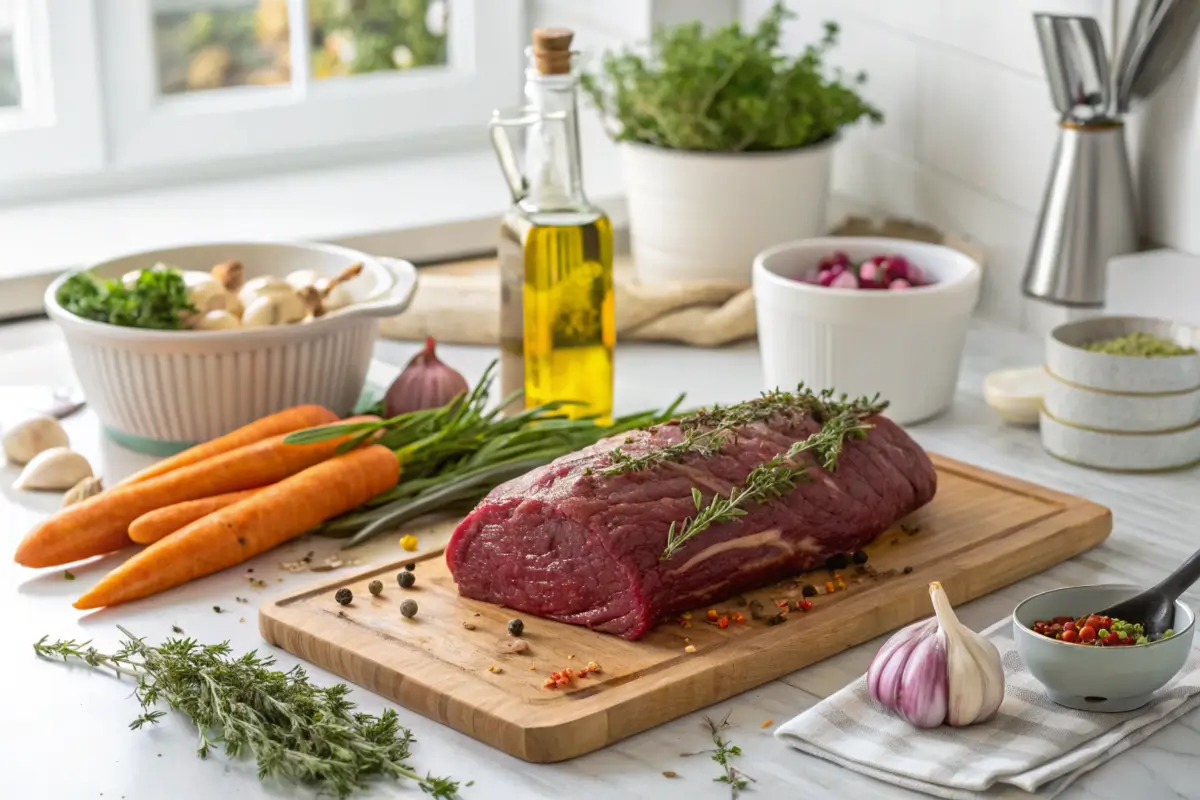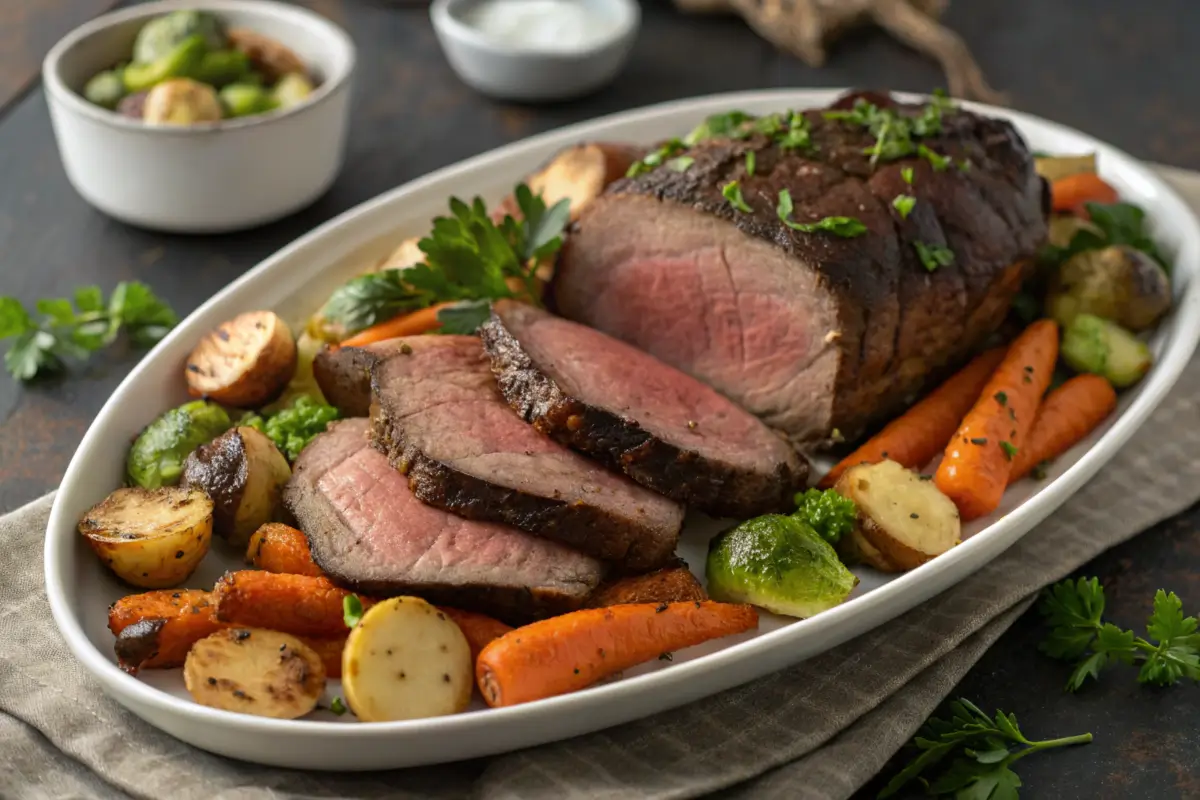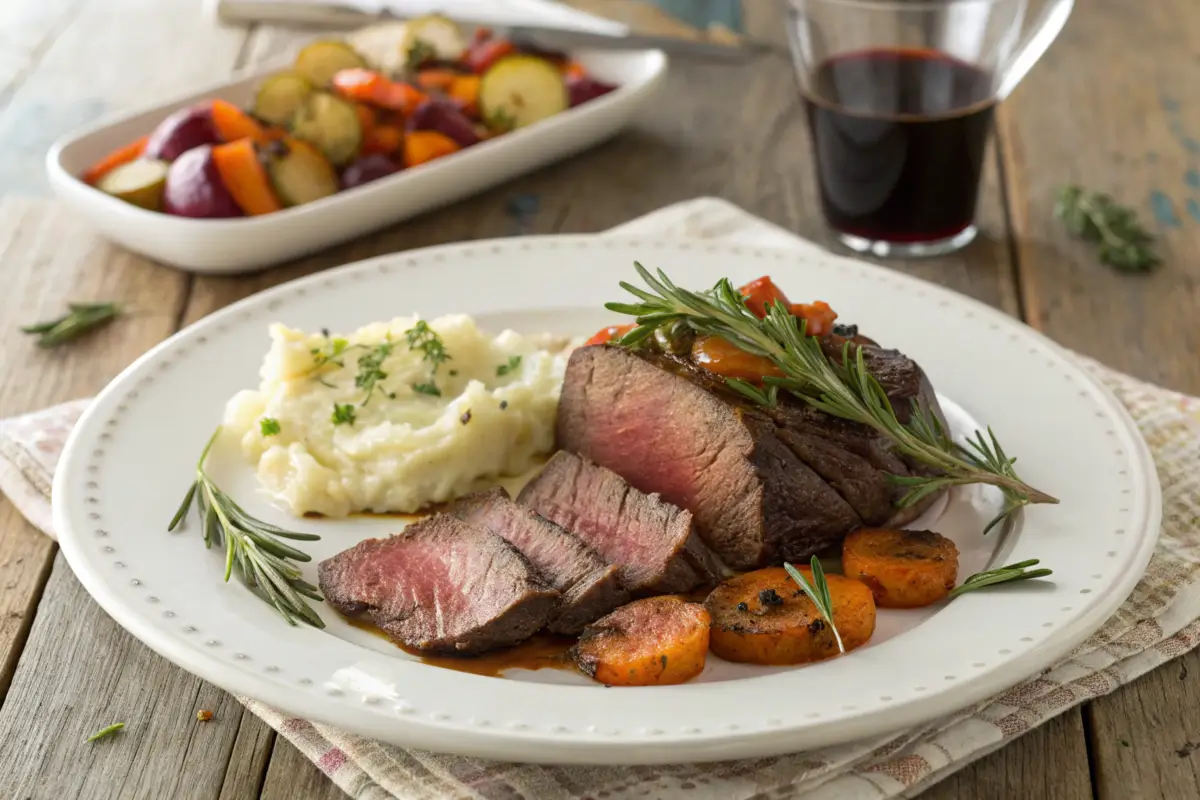Nothing quite beats the satisfaction of preparing a delicious venison roast recipe that’s both flavorful and tender. Whether you’re a seasoned hunter or someone exploring the culinary world of game meats, venison offers a unique taste that’s worth mastering. In this guide, we’ll walk you through everything from understanding venison to cooking methods, serving suggestions, and even avoiding common mistakes. By the end, you’ll be fully equipped to create a roast that will impress at any gathering. Let’s dive in!
Understanding Venison and Its Culinary Significance
To master a great venison roast recipe, it’s essential to first understand what makes venison so special. Its rich, earthy flavor and lean composition set it apart from other meats, making it a prized ingredient in kitchens worldwide.
What is Venison?
Venison refers to the meat of deer and sometimes extends to similar game animals like elk or antelope. It’s known for its lean texture, which makes it a healthier alternative to fattier meats like beef or pork. The flavor of venison is often described as earthy or slightly gamey, depending on the animal’s diet and habitat.
Nutritional Benefits of Venison Meat
Packed with protein and low in fat, venison is a fantastic choice for health-conscious eaters. A typical serving of venison is high in essential nutrients like iron, zinc, and B vitamins. Unlike conventional red meats, it’s also lower in cholesterol, making it an excellent option for a lean meat roast preparation.
Cultural and Historical Importance of Venison in Cuisine
Historically, venison has been a staple in many cultures, especially in regions where deer hunting was a way of life. From medieval feasts in Europe to traditional dishes in North America, venison has a legacy of being both a luxurious and practical food source. Modern chefs and home cooks alike continue to celebrate its versatility and flavor.
Selecting the Ideal Venison Cut for Roasting
Choosing the right cut is crucial for a successful venison roast recipe. The cut determines the meat’s tenderness and flavor, directly impacting your dish’s outcome.
Different Cuts of Venison Suitable for Roasting
When preparing a venison roast, certain cuts stand out for their suitability:
- Haunch (Rear Leg): This large, tender cut is perfect for roasting, offering a rich flavor and succulent texture.
- Saddle (Back): Known for its tenderness, the saddle provides premium meat ideal for roasting whole or in sections.
- Shoulder: While slightly tougher, the shoulder becomes tender and flavorful when slow-roasted, making it a great choice for hearty meals.
Tips for Choosing Fresh and Quality Venison
Selecting high-quality venison ensures a delicious roast:
- Color: Fresh venison should have a deep, reddish-brown hue. Avoid meat with a dull or grayish appearance.
- Texture: Look for firm, moist meat without excessive liquid in the packaging, indicating freshness.
- Smell: Fresh venison has a clean, slightly sweet aroma. A strong, off-putting odor suggests spoilage.
Considerations for Sourcing Venison: Farm-Raised vs. Wild Game
Your venison’s origin influences its flavor and texture:
- Farm-Raised Venison: Typically more consistent in taste and tenderness due to controlled diets and environments. It’s often milder and less gamey.
- Wild Game Venison: Offers a richer, more robust flavor, reflecting the animal’s natural diet. However, it can be less tender and vary in taste.
Understanding these factors helps you select the best venison cut for your roast, setting the foundation for a delectable meal.
Preparing the Venison Roast
Proper preparation elevates your venison roast recipe, enhancing its natural flavors and ensuring a tender, juicy result.

Essential Ingredients for a Venison Roast Recipe
To create a mouthwatering venison roast, gather these key ingredients:
- Venison Roast: Choose a cut suitable for roasting, such as haunch or saddle.
- Marinade Components: Olive oil, red wine or balsamic vinegar, garlic, and herbs like rosemary and thyme.
- Seasonings: Salt, black pepper, and additional spices to taste.
- Aromatics: Onions, carrots, and celery to add depth of flavor during roasting.
Marinating Techniques to Enhance Flavor and Tenderness
Marinating infuses the venison with flavor and helps tenderize the meat:
- Prepare the Marinade: Combine olive oil, red wine or vinegar, crushed garlic, and your choice of herbs in a bowl.
- Submerge the Venison: Place the venison roast in a resealable plastic bag or shallow dish, covering it with the marinade.
- Marinate Time: Refrigerate for at least 4 hours, preferably overnight, turning occasionally to ensure even exposure.
- Pat Dry Before Cooking: Remove the venison from the marinade and pat it dry with paper towels to promote better browning during cooking.
Seasoning Options: Herbs and Spices That Complement Venison
Enhance your venison roast with these seasoning suggestions:
- Herbs: Rosemary, thyme, sage, and bay leaves pair exceptionally well with venison.
- Spices: Black pepper, juniper berries, and a touch of allspice add warmth and complexity.
- Citrus Zest: A hint of orange or lemon zest can brighten the dish and balance the rich flavors.
By thoughtfully selecting ingredients, marinating properly, and choosing complementary seasonings, you’ll set the stage for a venison roast that’s both flavorful and tender.
Cooking Methods for Venison Roast
Mastering various cooking methods can elevate your venison roast recipe, ensuring a delectable and tender dish. Let’s explore some popular techniques to achieve this.
Oven-Roasting Venison: Step-by-Step Guide
Oven-roasting is a classic method that brings out the rich flavors of venison. Here’s how to do it:
- Preheat the Oven: Set your oven to 375°F (190°C).
- Prepare the Roast: Season the venison with salt, pepper, and your choice of herbs. For added flavor, consider searing the meat in a hot skillet until browned on all sides.
- Roasting: Place the venison on a rack in a roasting pan. Insert a meat thermometer into the thickest part of the roast. Roast until the internal temperature reaches 135°F (57°C) for medium-rare, approximately 20 minutes per pound.
- Resting: Remove the roast from the oven and let it rest for 10-15 minutes. This allows the juices to redistribute, resulting in a moist and tender roast.
Slow Cooker Venison Roast: Achieving Tender Results
Using a slow cooker is an excellent way to ensure a tender venison roast:
- Sear the Meat: In a skillet, sear the venison on all sides to lock in juices.
- Prepare the Slow Cooker: Place chopped onions, carrots, and celery at the bottom of the slow cooker. Lay the seared venison on top.
- Add Liquid: Pour in beef broth or red wine to cover about halfway up the meat. Add herbs like rosemary and thyme for extra flavor.
- Cooking Time: Cover and cook on low for 6-8 hours, or until the meat is fork-tender.
- Serving: Once done, remove the venison and let it rest briefly before slicing. Use the remaining liquid to make a savory gravy.
Instant Pot Venison Roast: Quick and Flavorful Preparation
For a faster yet flavorful preparation, the Instant Pot is your friend:
- Sear the Roast: Using the ‘Sauté’ function, sear the venison on all sides in the Instant Pot.
- Add Ingredients: Add broth, herbs, and vegetables like potatoes and carrots to the pot.
- Pressure Cooking: Seal the lid and cook on high pressure for 60 minutes. Allow for a natural pressure release for about 15 minutes.
- Finish: Open the lid, remove the venison, and let it rest. You can thicken the remaining liquid to create a delicious gravy.
Grilling Venison Roast: Tips for Outdoor Cooking
Grilling adds a smoky flavor to your venison roast:
- Marinate: Marinate the venison for at least 4 hours to enhance flavor and tenderness.
- Preheat the Grill: Set up a two-zone fire on your grill, with one side hot and the other cooler.
- Sear and Cook: Sear the roast over high heat for a few minutes on each side. Then, move it to the cooler side, cover, and cook until the internal temperature reaches 135°F (57°C) for medium-rare.
- Rest Before Serving: Let the meat rest for 10 minutes before slicing to retain its juices.
By mastering these cooking methods, you can tailor your venison roast recipe to your preferred taste and available equipment, ensuring a delightful dining experience.
Serving Suggestions and Accompaniments
Pairing your venison roast with complementary sides and sauces enhances the overall dining experience. Here are some ideas to consider.

Ideal Side Dishes to Serve with Venison Roast
Choosing the right side dishes can elevate your meal:
- Roasted Vegetables: Carrots, parsnips, and Brussels sprouts roasted with olive oil and herbs make a hearty accompaniment.
- Mashed Potatoes: Creamy mashed potatoes provide a comforting balance to the rich venison.
- Wild Rice Pilaf: The nutty flavor of wild rice pairs well with game meats like venison.
Sauces and Gravies That Enhance Venison Flavor
A well-chosen sauce can complement the unique taste of venison:
- Red Wine Reduction: A sauce made with red wine, shallots, and beef stock adds depth to the dish.
- Cranberry Sauce: The tartness of cranberries contrasts beautifully with the savory meat.
- Mushroom Gravy: Earthy mushrooms in a rich gravy bring out the best in a venison roast.
Wine Pairings for Venison Dishes
Selecting the right wine enhances the flavors of your meal:
- Bold Reds: Wines like Cabernet Sauvignon or Syrah match the robust flavor of venison.
- Pinot Noir: Its lighter body and fruity notes offer a pleasant contrast.
- Zinfandel: With its spicy undertones, Zinfandel complements the gamey nature of venison.
By thoughtfully selecting side dishes, sauces, and wines, you can create a well-rounded and memorable dining experience centered around your venison roast.
Common Mistakes to Avoid When Cooking Venison
Even the best intentions can lead to missteps in the kitchen. Avoid these common mistakes to ensure your venison roast recipe turns out perfectly every time.
Overcooking: Maintaining Juiciness and Tenderness
One of the most frequent pitfalls is overcooking venison. Since it’s a lean meat, it can dry out quickly if cooked for too long. To prevent this:
- Use a Meat Thermometer: Always monitor the internal temperature. For a juicy roast, aim for 135°F (57°C) for medium-rare.
- Avoid High Heat for Extended Periods: Instead, opt for slow and steady cooking methods, like slow roasting or using a crockpot.
- Rest the Meat: After cooking, let the venison rest to allow the juices to redistribute.
Improper Seasoning: Balancing Flavors Appropriately
While venison has a robust flavor, it still benefits from proper seasoning:
- Don’t Overdo It: Avoid overwhelming the natural taste of venison with too many spices or herbs. A simple blend of rosemary, thyme, and garlic often works wonders.
- Marinate Thoughtfully: Marinating not only tenderizes the meat but also complements its unique flavor. Be sure to strike a balance between acidic and savory ingredients.
Neglecting Resting Time: Ensuring Optimal Texture
Resting your venison roast is crucial, yet it’s a step many skip. When meat is removed from heat, the juices inside are still active. Resting allows these juices to settle, making the meat moist and tender.
- How Long to Rest: Let your roast rest for at least 10-15 minutes before carving. Cover it loosely with foil to retain heat without trapping moisture.
By steering clear of these common mistakes, you’ll consistently produce a venison roast recipe that’s both flavorful and tender.
Frequently Asked Questions about Venison Roast Recipe
Curious about cooking venison? These FAQs address common concerns to help you perfect your venison roast recipe.
How Do I Eliminate the Gamey Taste from Venison?
The “gamey” flavor of venison can be reduced with proper preparation:
- Marinate the Meat: Using ingredients like buttermilk, or vinegar can neutralize stronger flavors.
- Trim Excess Fat: The fat on venison often carries the gamey taste. Removing it can significantly mellow the flavor.
- Soak in Saltwater: A simple saltwater soak for a few hours before cooking can also help draw out unwanted flavors.
What Internal Temperature Should Venison Roast Reach for Safe Consumption?
For safety and taste, venison should be cooked to:
- Medium-Rare: 130°F to 135°F (54°C to 57°C). This keeps the meat tender and juicy.
- Medium: 140°F to 145°F (60°C to 63°C). This is still moist but slightly firmer.
Avoid cooking beyond 145°F, as venison can become tough and dry.
Can I Substitute Venison with Other Meats in Roast Recipes?
Yes, venison can often be swapped with lean meats like beef or lamb in roast recipes. However, remember:
- Cooking Times May Vary: Lean meats like venison cook faster than fattier cuts.
- Adjust Seasoning: Venison has a distinct flavor, so modify spices and marinades to suit the substituted meat.
How Should I Store and Reheat Leftover Venison Roast?
Proper storage ensures your leftovers remain delicious:
- Refrigerate Promptly: Store in an airtight container within two hours of cooking. Consume within 3-4 days.
- Reheat Gently: Use a low oven temperature or microwave with a splash of broth to prevent drying out.
With these insights, you’ll confidently handle every aspect of your venison roast recipe, from preparation to reheating. Ready to take your cooking to the next level? Let’s move on to exploring recipe variations!
Health Considerations and Dietary Information
Venison is not only delicious but also a healthy choice for a lean protein. Let’s explore its nutritional benefits and considerations.
Calorie and Protein Content of Venison Roast
One of the reasons venison is so popular among health-conscious eaters is its nutritional profile:
- Low in Calories: A 3-ounce serving of venison contains approximately 135 calories, making it a great option for those watching their intake.
- High in Protein: With over 26 grams of protein per serving, venison supports muscle growth and repair.
- Rich in Iron and B Vitamins: Venison is an excellent source of heme iron, which is easily absorbed by the body, and B vitamins like B12 and B6.
Venison as a Lean Meat Option
Compared to beef or pork, venison has significantly less fat:
- Lean and Mean: Venison’s low fat content makes it ideal for those on low-fat or heart-healthy diets.
- Nutrient-Dense: It provides essential nutrients without excess calories or unhealthy fats.
Allergy and Dietary Restrictions Related to Venison
While venison is suitable for most diets, there are some considerations:
- Game Meat Allergies: Rare, but some individuals may have sensitivities to game meats.
- Sustainability: Wild venison is often seen as a sustainable choice, but ensure that your meat is ethically sourced.
By understanding the nutritional benefits and considerations, you can feel good about incorporating a venison roast recipe into a balanced diet. Whether for health reasons or culinary exploration, venison remains a fantastic choice.

